Chevrolet Equinox Owners Manual: Cooling System
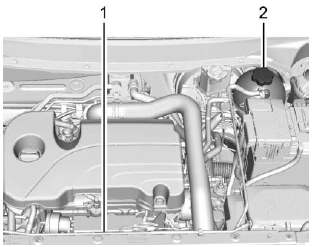
1.5L Gas Engine
- Engine Cooling Fan (Out of View)
- Engine Coolant Surge Tank and Pressure Cap
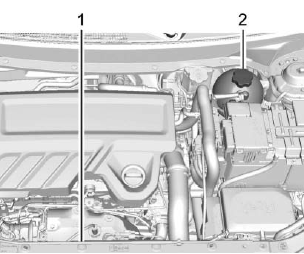
1.6L Diesel Engine
- Engine Cooling Fan (Out of View)
- Engine Coolant Surge Tank and Pressure Cap
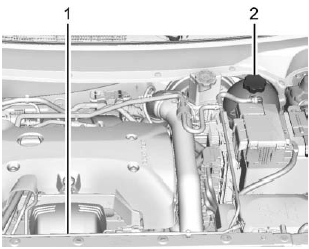
2.0L Gas Engine
- Engine Cooling Fan (Out of View)
- Engine Coolant Surge Tank and Pressure Cap
| Warning
An underhood electric fan can
start up even when the engine is
not running and can cause injury. Keep hands, clothing, and tools away from any underhood electric fan. |
If the coolant inside the coolant surge tank is boiling, do not do anything else until it cools down.
The vehicle should be parked on a level surface.
The coolant level should be at the top rib on the middle of the tank. If it is not, the vehicle may have a leak at the radiator hoses, heater hoses, radiator, water pump, or somewhere else in the cooling system.
| Warning
Do not touch heater or radiator
hoses, or other engine parts. They can be very hot and can burn you. Do not run the engine if there is a leak; all coolant could leak out. That could cause an engine fire and can burn you. Fix any leak before driving the vehicle. |
If there seems to be no leak, with the engine on, check to see if the electric engine cooling fan is running. If the engine is overheating, the fan should be running. If it is not, the vehicle needs service. Turn off the engine.
| Caution Do not use anything other than a mix of dexcool coolant that meets GM Standard GMW3420 and clean, drinkable water. Anything else can cause damage to the vehicle's engine cooling system and vehicle, which would not be covered by the vehicle warranty. |
Engine Coolant
The engine cooling system in the vehicle are filled with dexcool engine coolant mixture. This coolant needs to be checked and changed at appropriate levels.
See Recommended Fluids and Lubricants and Maintenance Schedule.
The following explains the cooling systems and how to check and add coolant when it is low. If there is a problem with engine overheating, see Engine Overheating.
What to Use
| Warning Plain water, or other liquids such as alcohol, can boil before the proper coolant mixture will. With plain water or the wrong mixture, the engine could get too hot but there would not be an overheat warning. The engine could catch fire and you or others could be burned. |
Use a 50/50 mixture of clean, drinkable water and dexcool coolant. If using this mixture, nothing else needs to be added.
This mixture:
- Gives freezing protection down to −37 C (−34 F), outside temperature.
- Gives boiling protection up to 129 C (265 F), engine temperature.
- Protects against rust and corrosion.
- Will not damage aluminum parts.
- Helps keep the proper engine temperature.
| Caution Do not use anything other than a mix of dexcool coolant that meets GM Standard GMW3420 and clean, drinkable water. Anything else can cause damage to the vehicle's engine cooling system and vehicle, which would not be covered by the vehicle warranty. |
Never dispose of engine coolant by putting it in the trash, pouring it on the ground, or pouring into sewers, streams, or bodies of water. Have the coolant changed by an authorized service center, familiar with legal requirements regarding used coolant disposal. This will help protect the environment and your health.
Checking Coolant
The vehicle must be on a level surface when checking the coolant level.
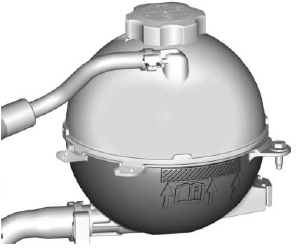
Check to see if coolant is visible in the coolant surge tank. If the coolant inside the coolant surge tank is boiling, do not do anything else until it cools down. If coolant is visible but the coolant level mark is not visible, add a 50/50 mixture of clean, drinkable water and dexcool coolant at the coolant surge tank to the top rib on the middle of the tank, but be sure the cooling system is cool before this is done. See Engine Overheating.
The coolant surge tank is located in the engine compartment on the driver side of the vehicle. See Engine Compartment Overview.
How to Add Coolant to the Surge Tank
| Warning Spilling coolant on hot engine parts can burn you. Coolant contains ethylene glycol and it will burn if the engine parts are hot enough. |
| Warning
Steam and scalding liquids from a
hot cooling system are under
pressure. Turning the pressure
cap, even a little, can cause them
to come out at high speed and
you could be burned. Never turn
the cap when the cooling system,
including the pressure cap, is hot. Wait for the cooling system and pressure cap to cool. |
| Caution Failure to follow the specific coolant fill procedure could cause the engine to overheat and could cause system damage. If coolant is not visible in the surge tank, contact your dealer. |
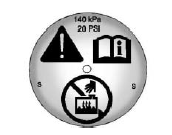
The coolant surge tank pressure cap can be removed when the cooling system, including the surge tank pressure cap and upper radiator hose, is no longer hot.
- Turn the pressure cap slowly
counterclockwise. If a hiss is
heard, wait for that to stop.
A hiss means there is still some pressure left.
- Keep turning the pressure cap slowly and remove it.
- Fill the coolant surge tank with the proper mixture to the mark pointed to on the front of the coolant surge tank.
- With the coolant surge tank pressure cap off, start the engine and let it run until you can feel the upper radiator hose getting hot. Watch out for the engine cooling fans. By this time, the coolant level inside the coolant surge tank may be lower. If the level is lower, add more of the proper mixture to the coolant surge tank until the level reaches the mark pointed to on the front of the coolant surge tank.
- Replace the pressure cap tightly.
| Caution If the pressure cap is not tightly installed, coolant loss and engine damage may occur. Be sure the cap is properly and tightly secured. |
 How to Reinstall the Engine Air Cleaner/Filter
How to Reinstall the Engine Air Cleaner/Filter
Align the air cleaner/filter with
the indicated point on the base
of the air cleaner/filter housing
and install the air cleaner/filter.
The outer air cleaner/filter seal
must be fitte ...
 Engine Overheating
Engine Overheating
The vehicle has an engine coolant
temperature gauge on the
instrument cluster and overheat
messages in the Driver Information
Center (DIC) to warn of engine
overheating. See Engine Coolant
Tempe ...
Other materials:
Removing the Flat Tire and Installing the Spare Tire
Do a safety check before
proceeding. See If a Tire Goes
Flat for more information.
For vehicles with a wheel cover
or center cap, pull the cover or
center cap away from the
wheel to remove it. Store the wheel cover in the cargo area
until you have the flat tire
repaired or r ...
